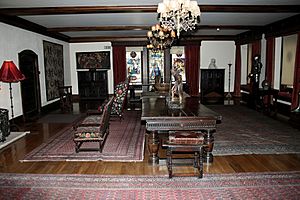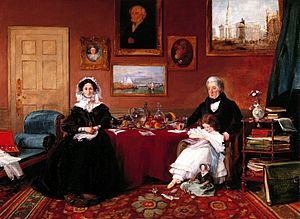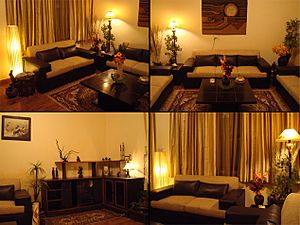Drawing room facts for kids

A drawing room is a special room in a house. It's a place where people can entertain guests. You might also hear it called a living room.
The name "drawing room" comes from older terms like "withdrawing room" or "withdrawing chamber." These names were used in the 16th and 17th centuries. The first time "drawing room" was written down was in 1642.
In big English houses from the 1500s to the early 1700s, a withdrawing room was a private space. The owner of the house, their spouse, or an important guest could "withdraw" to this room. It was a quiet place to get away from the main busy areas. This room was often next to the main hall or a fancy "state room." It usually led to a formal bedroom.
Today, in modern houses, a drawing room might just be another living space. It's often a second or extra room for guests. It doesn't always have a specific special use anymore.
Contents
What is a Drawing Room?
How the Name Came About
The idea of a "drawing room" started with the "withdrawing room." This was a room where people could "withdraw" or step away from a larger, more public space. It offered more privacy.
In the 16th and 17th centuries, important people in big houses needed a place to relax. They might want to talk privately or simply escape the noise. The withdrawing room served this purpose.
Early Uses and Royal Connections
In 18th-century London, royal morning gatherings were called "drawing rooms." This was because important court members would wait in a drawing room outside the king's bedroom. The king would then make his first public appearance of the day there.
During the American Civil War, the White House of the Confederacy had a drawing room. It was next to the main parlor. The president, Jefferson Davis, would greet his guests in the parlor. After greetings, the men would stay in the parlor to discuss politics. The women would then move to the drawing room for their own conversations. This was a common social custom among wealthy families in the Southern United States.
Defining the Drawing Room in the Past
In 1865, an English book about architecture described a drawing room. It said it was mainly a room for ladies. It was like a modern version of the old "Lady's Withdrawing-room."
If a house didn't have a "morning room," the drawing room was the main family sitting room. Ladies would receive visitors there throughout the day. The family and their guests would gather there before dinner.
After dinner, the ladies would go to the drawing room. Later, the gentlemen would join them for the evening. It was also the main room for evening parties. The book noted that drawing rooms were similar in purpose, whether in a duchess's home or a simpler gentlewoman's house. The main differences were size and how fancy they looked.
A small drawing room might be about 16 feet wide and 18 to 20 feet long. A good size was 18 by 24 feet. Very large ones could be 20 by 30 feet or even 26 by 40 feet.
Drawing Rooms Today
Until the mid-1900s, a tradition at dinner parties was for the ladies to leave the dining table. They would go to the drawing room. The gentlemen would stay at the table. They would often enjoy brandy or cigars. After a while, the gentlemen would join the ladies in the drawing room.
The term "drawing room" is not used as much as it used to be. In Britain, it's mostly used by people who have other special rooms. These might include a "morning room" or a "lounge." A morning room was a sitting room, often facing east for morning sunlight. A lounge was a room for relaxing.
So, the drawing room became the fanciest room in the house. Adults often used it for entertaining guests. This term is still widely used in India and Pakistan. This probably comes from the time when Britain ruled these countries. It's common in larger city houses that have many rooms.
The word "parlor" first meant a simpler reception room for middle-class families. But in the UK, people started using it less. They wanted to sound more like the wealthy. In North America, "parlor" was common until the early 1900s. In France, the word "salon" began to mean a drawing room in the early 1800s. This was because of the popular social gatherings called "salons."
Drawing Rooms on Trains
The term "drawing room" was also used for special train cars. It meant some of the biggest and most expensive private spaces on a sleeping car or private train. For example, in 1874, the Midland Railway had a "Drawing Room Car." It was made by the Pullman Company and brought from the United States.
In North America, a drawing room on a train meant a private room. It could sleep three or more people. It also had its own private washroom.
Today, Amtrak no longer uses sleeping cars with drawing rooms. But Via Rail Canada still has them. The old name is not used much anymore. So, they are now called "triple bedrooms" instead.
Drawing Room Plays
A drawing room is a place to entertain visitors. This gave its name to a type of play called a "drawing room play." These are plays and movies that often take place in a drawing room setting.
Drawing room plays started as early forms of drama. They have grown to include comedies and even dramatic monologues. While the actual drawing room is less common now, this type of play is still popular.
What is Drawing Room Comedy?
Drawing room comedy usually features clever jokes and witty conversations. The characters are often wealthy, have a lot of free time, and are from the upper class. This type of comedy is sometimes called "comedy of manners."
Famous examples include Oscar Wilde's 1895 play The Importance of Being Earnest. Several plays by Noël Coward are also typical of this style. George Bernard Shaw's 1919 play Heartbreak House also fits this style. But it adds some social criticism.
The actor Cary Grant appeared in many filmed drawing-room comedies. Ernst Lubitsch was a director especially known for making drawing room comedies.
See also
 In Spanish: Salón para niños
In Spanish: Salón para niños



